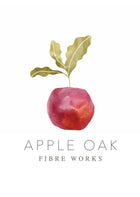

OAK BARK DYE (Quercus spp.)
Dye Colour: Golden Beige and Browns | Country of Collection: Poland
Oak Bark is a tannin-rich, natural dye source used for centuries to achieve warm, earthy tones on wool and silk. Thanks to its high tannin content, no mordant is strictly necessary, but will result in better colour fastness. Experimenting with iron and adding oak galls can deepen or modify your results. Lighter beige tones emerge with lower pH (around 5), and deeper browns develop under higher pH (around 8), though iron is a more stable solution for darker tones.
Colour Fastness: Good
Colour Outcomes by WOF Ratio
-
50–100% WOF Oak Bark
Produces a range of golden beige to medium browns, with the flexibility to go darker by adjusting the pH or boosting tannins with oak galls.
Basic Recipe for Dyeing
Ingredients:
- 50–100% Oak Bark (by weight of fibre)
- Wool or Silk (mordant not strictly necessary due to high tannin content)
Instructions:
- Soak the oak bark overnight in water.
- Simmer the soaked bark for 2 hours, then strain through a cloth.
- Add wool or silk to the dye bath.
- Simmer gently for 1 hour.
- Cool & Rest: Allow the fibre to soak in the dye bath overnight to deepen the colour.
- Rinse & Dry: Rinse the dyed fibre in cool water and hang to dry.
Embrace the rich tradition of oak bark dye and bring timeless, organic hues to your fibre projects—perfect for both beginners and seasoned natural dyers.
Join The Natural Dyers & Growers Academy to share your experiences, join courses and get support from fellow growers and dyers.












